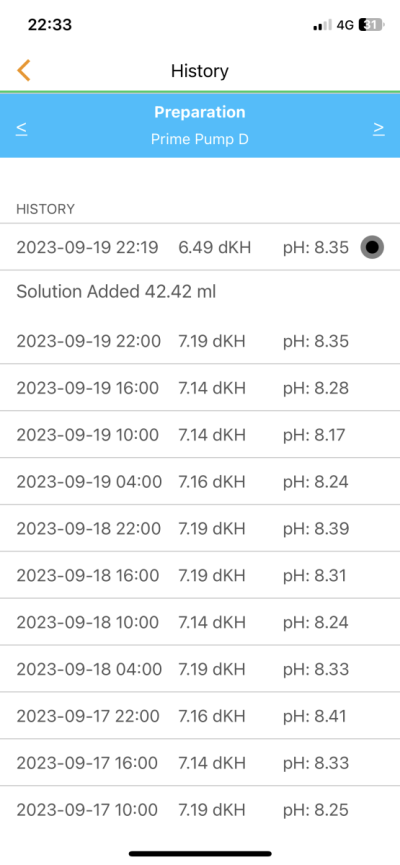Ya, I was kind of thinking that the limited range of the Alkatronic's calibration was affecting the readings above 7.0 pH. After switching to a new pH probe in my sump (hooked to my Atlas hardware), I get similar readings to what I was getting with the Milwaukee probe (which was also fairly new).Remember with your probes in the tank that are staying in the water all the time you need to take much longer time to calibrate. This can be a pain with the limited calibration in the Alkatronic, I find it strange they did not give us the native controls of the Atlas Scientific pH board and let us do 3 point calibration and/or not be restricted by the Alkatronic time out during calibration. It takes from 15mins to 30mins in each buffer solution to calibrate a probe that is continuously immersed, at least you can leave the probe in the ph7 buffer for a while before starting calibration on the Alkatronic but alas not for pH4 buffer and no pH10 buffer despite samples starting well above pH7.
Unfortunately all these companies for some reason persist with using pinpoint calibration designed for a probe only being used for a few minutes at a time, but we are using the probes constantly so they need another form of calibration. You can tell if you probe is incorrectly calibrated, just put it back in some pH 7 buffer and come back in a hour and see how much it has drifted from 7 after that hour. If it drifts less than 0.01 then you good to go, if it drifts more than this then you need to leave it in each buffer solution longer before calibration. The older the probe the longer the buffer soak time.
My hydro setups are almost completely automated and manage the pH control precisely (along with other chemistry and environmental controls). There is one thing you have to have when continuously controlling pH, and that is more than 1 pH probe being used to take the pH readings for the control loop. A probe can throw a wild reading easily and this needs to be managed through multiple probes and a bunch of additional safety controls. I often laugh at how poor the brand name controllers are for reef aquariums, their poor choice of components, the terrible programming and silly limitations baked in especially when you consider how many are using Atlas Scientific for the bulk of the hardware and open source libraries. Just amazes me we don't see more lift and shift from the hydro world considering how much better most of the products are. A prime example is the Alkatronic with a Pi Zero hooked via I2C to a custom daughter board populated with Atlas Scientific components and motor drivers, when for far less you could have just run a standard Atlas Scientific board that stacks on a pi 3 or 4 (and fix the poor responsiveness of a Pi Zero) with Atlas Scientific peristaltic pumps with the motor drivers onboard the motors..... like in hydro. Then bloody formal coat the electronic boards seeing as we are dealing with a hostile environment for electronics inside the case where the electronics are housed....
As for the reagent, I buy 2N Sulfuric acid (about $25USD per litre locally) and use a precision pipette dispenser to make up a couple of 5ltrs containers at a time. It is the cheapest option locally (I have 4x Alkatronics on test every 3 hours) and I already have the precision dispensing needed to keep things accurate (about another $20USD if you had to buy the pipette and tips if you are playing along at home). I dump the waste back into the sump via a couple of chambers (the inline ones used for refillable DI resin) full of reborn and coarse oolite aragonite to reduce any impact on alk or pH. I measure the RO/DI water by weight and the acid by volume when preparing the final reagent solution. Although this is the cheapest and easiest option for me, it by no means is the safest and you should definitely be in appropriate PPE when playing with this concentration of sulfuric acid.
Currently my 24 hour daily pH readings are 8.03 - 8.12 for the sump probe and 8.08 - 8.22 for the Alkatronic. I attribute the low daily high readings to the unlit portion of my system, meaning either my coral mass when the lights are off, or my fuge when the grow light is off. I keep a large amount of macro growing in a barrel, and expect that it limits my daily lows, and also (unfortunately) the daily highs.
During the last 24 hours, my dKH has been 8.62 - 8.67, testing every 3 hours.
I hear ya on the need for multiple probes. I use a custom ATO that I developed that operates on EC. The common advice is to never depend on EC for salinity control, and it's good advice, because a single EC probe will not give a dependable enough response to allow for safe salinity control. That is why I use 5 EC probes in my ATO controller. I originally used 3 Atlas Scientific EC probes, and later added 2 Thermo Scientific Orion probes.
With just the 3 Atlas probes, the ATO was workable, but required more effort to keep calibrated than I liked. Our tanks are hostile environments for EC probes. There is always something that wants to live, crawl, or deposit on the surface of the EC electrodes. The 2 cell Atlas probes are especially vulnerable to being impacted. When I first started using the Atlas EC probes, I was a bit mystified why the readings jump around so much. I went back to Atlas staff multiple times questioning my results, but each time heard that they get very little reports of problems with the EC probes. I ended up building an in sump manifold to hold the 3 Atlas EC probes, hooked to a small Sicce pump to flow water past them continuously to discourage squatters. It works for the most part.
When I added the 2, Thermo Scientific probes, hooked up over USB using bench top meters, I attained far greater stability. They use 4 cell electrodes and are much more resistant to being impacted. They did bring their own communication issues though. I had to build in methods of resetting the USB port and the devices themselves when they stopped sending updates. I have them setup to send an update every 60 seconds.
I developed the ATO to head off potential issues that have bitten me in the past. Mainly my love of running dual headed, continuous water changes, and my misplaced trust that they will stay balanced over time. They never do, and that fact has led to a couple of crashes when things got way out of whack and I was asleep at the switch. So I decided to build a way of protecting from that issue, and it also protects against salinity errors on the new make up water. Even if I totally mess up mixing my make up water, the ATO fixes it for me.
It also corrects all effects from dosing 3 part (which I recently added). For people who use kalk exclusively, and run into the daily evaporation limit, this style of ATO could be employed to add concentrated brine to maintain correct salinity, regardless of how much kalk is required daily. A level control would then pump water out to waste to account for the excess water being added and corrected for by the ATO. Kind of an ATO and AWC all in one.
Using my ATO, I keep my salinity constrained to a 125 uS range (1.0263 - 1.0264). I consider this pretty stable.
Back on topic, handling the 10N muriatic acid that I had planned to sub in for the DIY reagent, along with the NaOH in my 3 part, are the only 2 things that give me great cause for concern. Having to mix new batches of reagent every few months using it, is one of the reasons I am looking at using the OEM again. Well that and the fact the OEM dropped in price to match the DIY version, which is no longer available locally anyway.
























